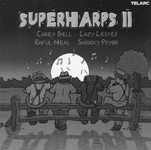|
Carey Bell, Lazy Lester, Raful Neal, & Snooky Pryor Superharps II Telarc 83514 Various Artists This is the Blues Harmonica Delmark DE-746 |

|
A harmonica can be haunting; it can be joyous, and it can feel suitable for so many blues moods. These two recent releases, saturated with harp and featuring multiple artists, illustrate the broad range of modern harmonica artistry.
Spanning half a century, the music on This Is the Blues Harmonica is offered in part as homage to the blues harp players who created a tradition and lent their own signatures to blues music, and in part as a tasty sampler from the Delmark catalog, with the title being a nod to Junior Wells. The album also demonstrates the influence of the Chicago blues harmonica scene in shaping many of the innovations and modern methods of harp playing.
Ranging from the rough 1950s cut "Sputnik" by Harmonica George (Smith) to more consummate tracks from the period like Little Walter’s "Red Headed Woman" and Big Walter Horton’s "Hard-Hearted Woman," the disc moves into the ’60s and ’70s, leaps over the ’80s, then offers eight tunes from the ’90s. The newer songs benefit from more polished production, but they also demonstrate that the blues harmonica is enjoying a renaissance, with numerous older players returning to recording and handing the harp over to a newer generation during the last decade or so.
Little Sammy Davis howls wolfishly on "Hey Little Girl," Golden "Big" Wheeler blows like the windy city on "Guilty," and Billy Boy Arnold muscles around his "Streetwise Advisor," making the music rock. The younger players on the block prove that they have mastered their chops too: Billy Branch punctuates Bonnie Lee’s singing on "I Got the Blues About My Baby" and Kim Wilson does a stinging turn on Steve Freund’s "‘C’ For Chicago."
This Is the Blues Harmonica also serves as a reminder that blues harp has been moaning and wailing a mournful sound for over a century and needs few present-day production techniques to make it memorable or moving. Cuts such as Carey Bell’s "Deep Down South" feel like they are carved into the collective blues consciousness and those alone would make the disc worth the price of admission. Yet it should also send harp fans back to important source material such as Hoodoo Man Blues by Junior Wells.
On the other hand, Superharps II uses today’s technology and a tight backing band to show off the talents of four harp players who can wail until the trains come home. Carey Bell, Lazy Lester, Raful Neal and Snooky Pryor show off their talents individually and collectively on this disc, further solidifying their places in blues history.
Following on the heels of the Grammy-nominated Superharps, this second harmonica super-session pairs another quartet of legendary harp players with essentially the same excellent band — Kid Bangham on guitar, pianist Anthony Geraci, Mudcat Ward on acoustic bass and drummer Per Hanson — to make a winning combo and some delicious music. Although the band comes close to overpowering these players a couple times, it backs off enough to remind us what we came to taste.
Carey Bell leads off with Muddy Waters’ "Walking Thru the Park." Anthony Geraci’s piano boogies and Bell blows the harp with passion, echoing his influences as well as those who have followed in his footsteps. Later, Bell renders Waters’ "She’s 19 Years Old" into a passionate narrative, adding a Snooky Pryor solo that communicates yearning and loss.
Bangham’s righteous guitar work accentuates Raful Neal’s "I Miss You Baby," and Neal’s scorching vocals make this slow blues smoke in an aural atmosphere imbued with that hazy, late-night club atmosphere. His "Starlight Diamond" simmers some country blues with a bit of bayou tossed in, and Lazy Lester peppers the mix with a savory solo.
The other stars of the show also provide some luminous moments when they take the lead. Pryor wails on "Keyhole in Your Door," with Carey Bell jumping in with a supporting solo. Pryor also sounds energized on "Let Your Hair Down," while Lazy Lester whets the appetite with "Strange Things Happen" and "I Made Up My Mind" and really reaches deep inside to reverberate the emotions with "Blood Stains on the Wall."
After letting each player cook through his solos before symbolically passing the harp, the disc closes with a grand harmonica finale, "Harp to Harp." By the time the last breath is blown, Superharps II has found another recipe for success. It’s probably only a matter of time before someone tries to make it into a franchise.
— John Koetzner
| ©2001 Blues Access, Boulder, Colorado, USA |